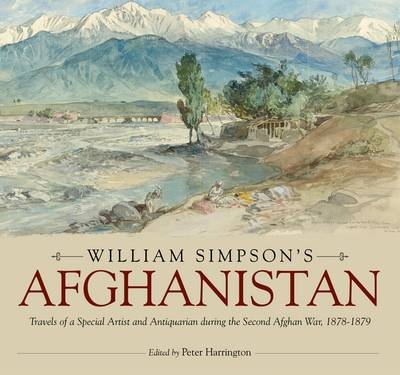
William Simpson’s Afghanistan
Travels of a Special Artist and Antiquarian During the Second Afghan War, 1878-1879
Seiten
2016
Helion & Company (Verlag)
978-1-909982-80-2 (ISBN)
Helion & Company (Verlag)
978-1-909982-80-2 (ISBN)
- Titel ist leider vergriffen;
keine Neuauflage - Artikel merken
"Left London, on a journey with Kabool as my objective via Brindisi and Bombay'. With these words written on Tuesday October 15, 1878, the Scottish artist William Simpson (1823-1899), commenced a daily journal which he later entitled Diary of a Journey to Afghanistan during the Campaign of 1878-79. Simpson was no stranger to the life of a 'special' having previously covered military campaigns in Abyssinia, France, and California on behalf of his employer, the Illustrated London News. Earlier, his efforts in the Crimean War had already established his reputation for accuracy and an eye for detail.
As an'embedded' artist with the Peshawar Valley Field Force, Simpson recorded the events leading up to the signing of the Treaty of Gandamak in May 1879 which brought the first phase of the Second Afghan War to a close. During his six months in Afghanistan, he sent back numerous sketches, drawings and watercolours accompanied by detailed captions to his newspaper in London. This period could be described as a 'phony war' as the British waited for the various tribal leaders to come into camp in Jalalabad and swear their allegiance to the British Government. The inactivity of the army with only the occasional punitive expedition to alleviate the boredom allowed Simpson to pursue his antiquarian interests by exploring caves and excavating several ancient Buddhist burial monuments known as stupas.
In addition to the finely detailed and exquisite pictures, Simpson's diary contains accounts of his studies of these ancient sites as well as commentaries on the people and places he observed. Upon his return to England, he collected all his original sketches, drawings and watercolors sent to'News and mounted them in two large albums, one dealing with the war, the people and the country, the other containing all his archaeological pictures.
The diary paints a rare picture of the life of a 19th century'special' artist in a war zone and the mechanics and editorial decisions that went into the pictorial coverage of a colonial war. It also offers a unique insight into early colonial archaeology undertaken by Simpson and a number of British officers while on campaign continuing the tradition of oriental scholarship among army officials. While much of this revolved around 'treasure hunting' Simpson went beyond this to understand the Buddhist culture that created the many monuments surrounding the Jalalabad Valley. This edition of the diary benefits from an extensive introduction and appendices.
As an'embedded' artist with the Peshawar Valley Field Force, Simpson recorded the events leading up to the signing of the Treaty of Gandamak in May 1879 which brought the first phase of the Second Afghan War to a close. During his six months in Afghanistan, he sent back numerous sketches, drawings and watercolours accompanied by detailed captions to his newspaper in London. This period could be described as a 'phony war' as the British waited for the various tribal leaders to come into camp in Jalalabad and swear their allegiance to the British Government. The inactivity of the army with only the occasional punitive expedition to alleviate the boredom allowed Simpson to pursue his antiquarian interests by exploring caves and excavating several ancient Buddhist burial monuments known as stupas.
In addition to the finely detailed and exquisite pictures, Simpson's diary contains accounts of his studies of these ancient sites as well as commentaries on the people and places he observed. Upon his return to England, he collected all his original sketches, drawings and watercolors sent to'News and mounted them in two large albums, one dealing with the war, the people and the country, the other containing all his archaeological pictures.
The diary paints a rare picture of the life of a 19th century'special' artist in a war zone and the mechanics and editorial decisions that went into the pictorial coverage of a colonial war. It also offers a unique insight into early colonial archaeology undertaken by Simpson and a number of British officers while on campaign continuing the tradition of oriental scholarship among army officials. While much of this revolved around 'treasure hunting' Simpson went beyond this to understand the Buddhist culture that created the many monuments surrounding the Jalalabad Valley. This edition of the diary benefits from an extensive introduction and appendices.
The book's editor, Peter Harrington, is Curator of the Anne S.K. Brown Military at Brown University Library in Providence, Rhode Island, USA.
| Erscheint lt. Verlag | 15.4.2016 |
|---|---|
| Zusatzinfo | c 16 colour & c 85 b/w illustrations |
| Verlagsort | Solihull |
| Sprache | englisch |
| Maße | 170 x 245 mm |
| Themenwelt | Kunst / Musik / Theater ► Kunstgeschichte / Kunststile |
| Reisen ► Reiseberichte ► Asien | |
| Geschichte ► Allgemeine Geschichte ► Neuzeit (bis 1918) | |
| Geisteswissenschaften ► Geschichte ► Regional- / Ländergeschichte | |
| ISBN-10 | 1-909982-80-6 / 1909982806 |
| ISBN-13 | 978-1-909982-80-2 / 9781909982802 |
| Zustand | Neuware |
| Haben Sie eine Frage zum Produkt? |
Mehr entdecken
aus dem Bereich
aus dem Bereich
Europa 1848/49 und der Kampf für eine neue Welt
Buch | Hardcover (2023)
DVA (Verlag)
CHF 67,20
Giordano Bruno - ein ketzerisches Leben
Buch | Hardcover (2024)
C.H.Beck (Verlag)
CHF 41,85


